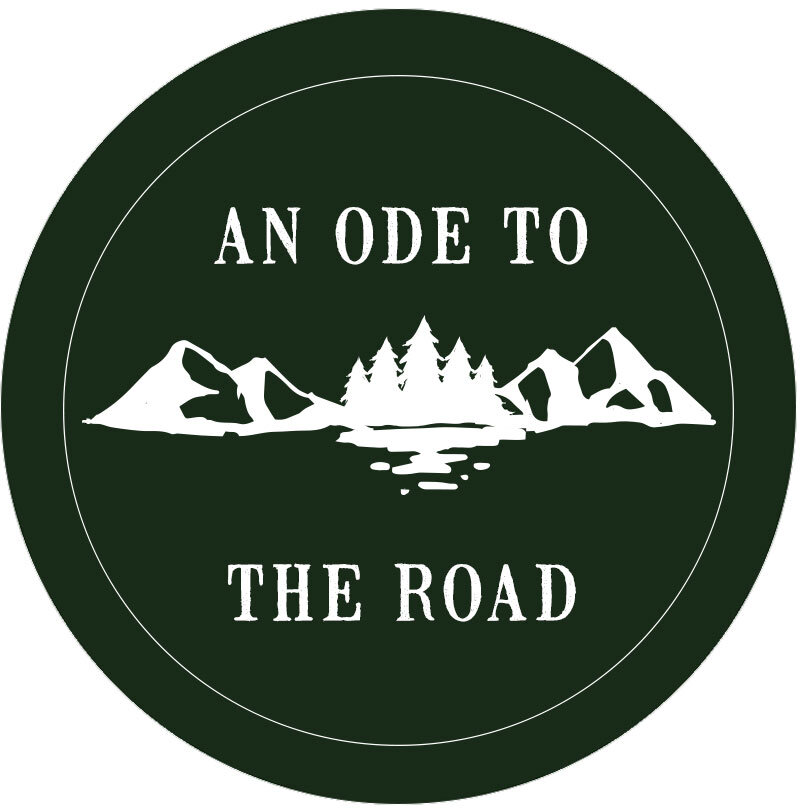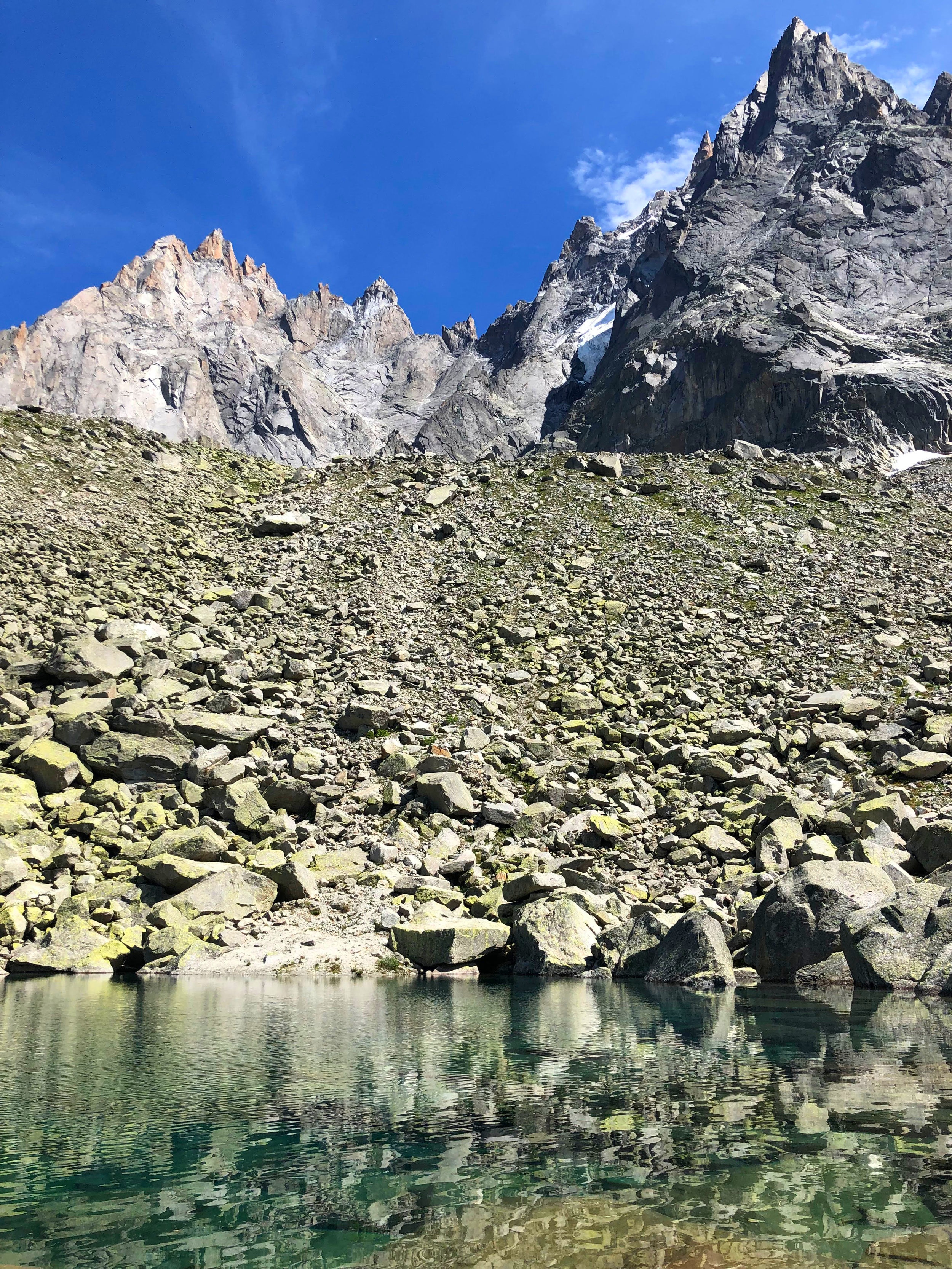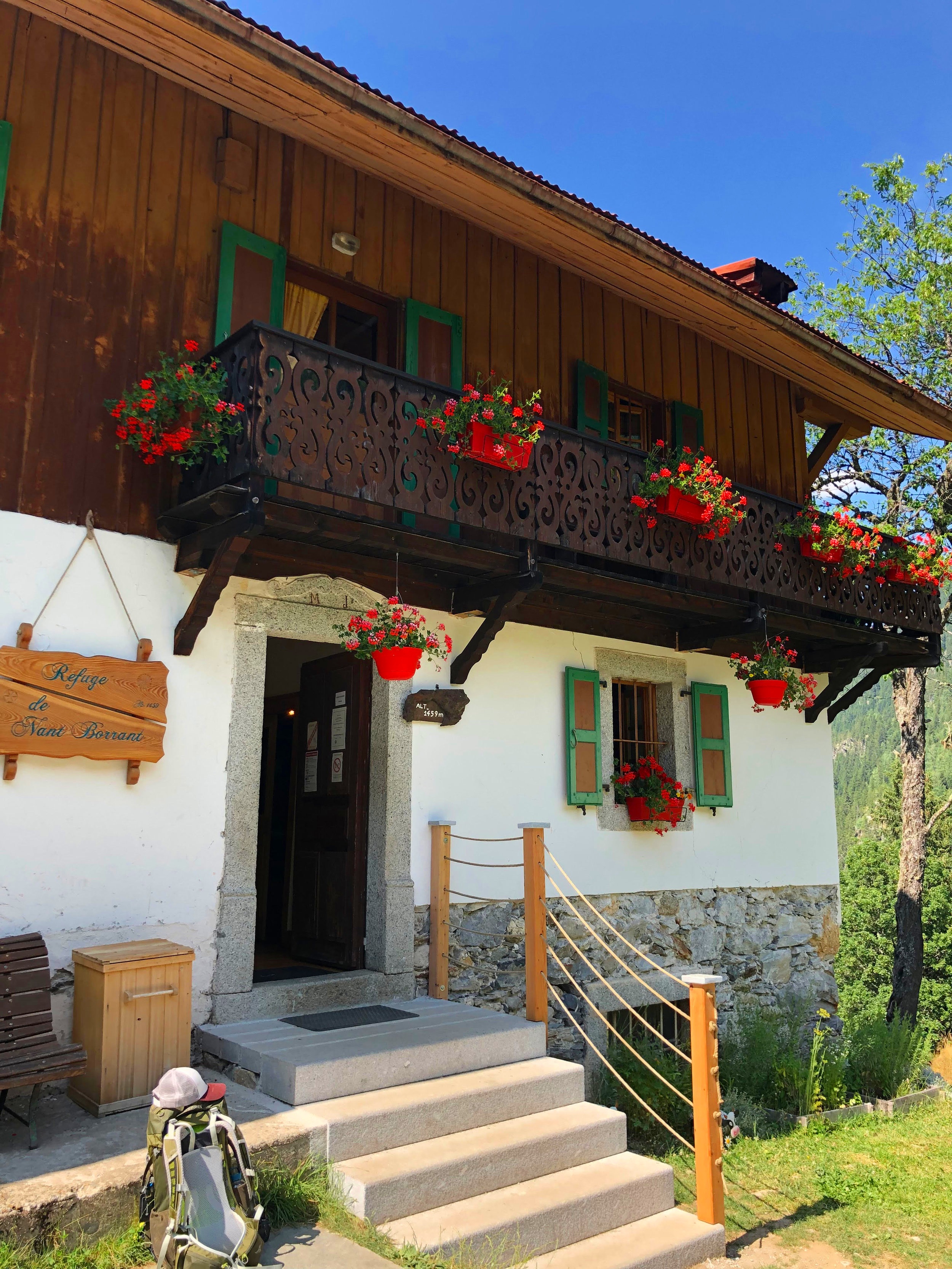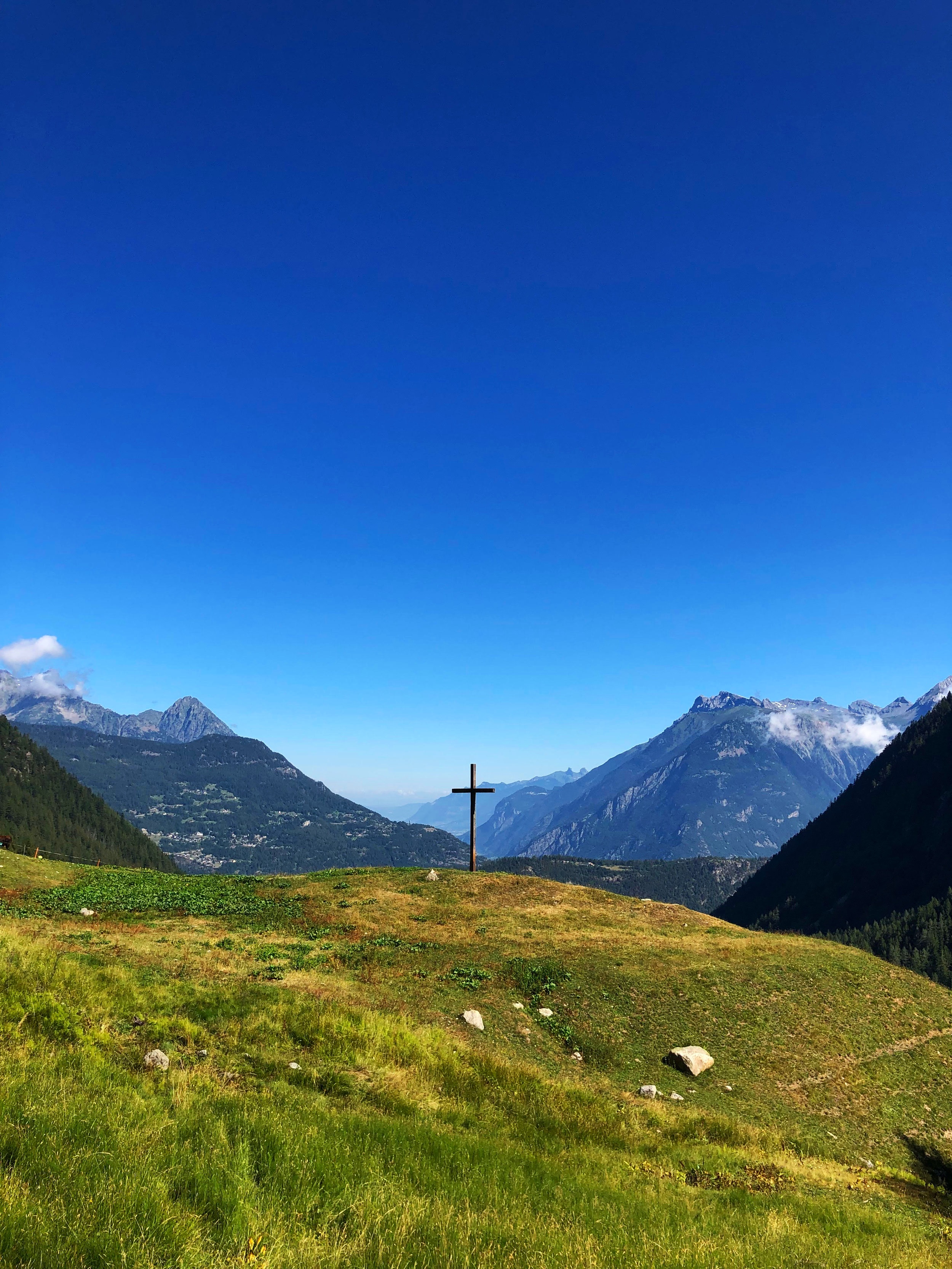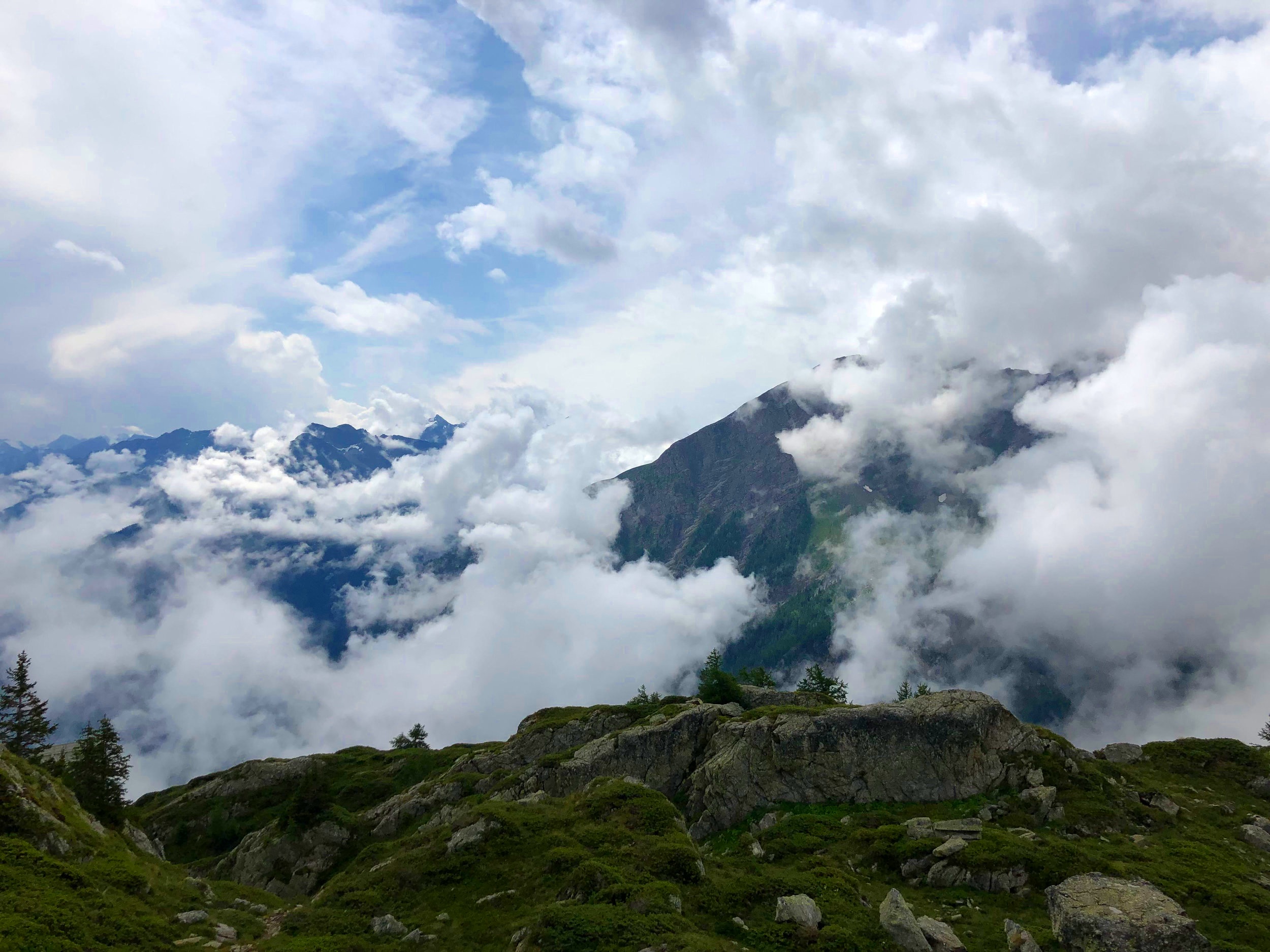Trekking the Tour du Mont Blanc
I was sitting in the grass stretching my legs when I heard Bernard behind me, the skin of the onions he’d plucked from his garden rustling faintly like dry leaves as he rolled them over in his hands for inspection.
Intently focused on his harvest, the Frenchman hadn’t noticed me, his neighbor for the evening courtesy of an AirBnb rental, until I mustered the courage to say “Bonjour” and embark on a brief conversation in stilted French. Bernard has spent his entire 83 years living in Chamonix-Mont-Blanc, in a modest house perched atop a steep hill on Rue La Mollard to the town’s northwest. It’s easy to see why he’s stayed. Chamonix is nestled in the foothills of the Alps in the shadow of Mont Blanc, the highest peak in Western Europe at nearly 16,000 feet, and from his elevated mountain-facing garden Bernard has arguably the best view in town.
In the fading evening light, the snow-capped summit, surrounding outcrops of granite and jagged waves of glacial ice burned orange as if bathed in fire. Before retiring inside to cook his onions, Bernard paused to drink in the view, a faint smile on his lips.
“Les montagnes sont beaux,” he said.
I spent 11 days in the mountains, hiking the Tour du Mont Blanc and exploring the Chamonix environs, and can vouch for Bernard’s description. It was, if anything, an understatement.
The Tour du Mont Blanc, a 106-mile trek around the Mont Blanc massif through France, Italy and Switzerland, led me through some of the most stunning vistas I’ve had the good fortune to behold: Green, grassy meadows extending up the hillside to the horizon, bursting with the blue, yellow, orange, red and violet pastels of blooming wildflowers; colossal needles of rock extending upward like inverted knives; vast snow fields, clinging to life despite the midsummer heat; shape-shifting plumes of cloud moving like wispy serpents among the highest reaches of rock.
Some landscapes were so pristine and grandiose as to invoke a sense of spirituality, like something straight out of a Renaissance-era tableau: from Grand Col Ferret, the tree-specked valley floor spread a kilometer below my feet; from Col de la Seigne, hiking past lakes and surging rivers of glacial meltwater on the descent into Italy; walking into the clouds in Switzerland, the snow-capped Grand Combin and Mont Vélan in the distance.
Juxtapose surreal panoramas with the small-town European charm of mountainside hamlets along the way and you get travel at its best: a mix of natural splendor and cultural richness.
Word seems to have gotten out about the region’s bounty. The population of the Chamonix valley, a collection of five small towns at the base of the Alps — Argentière, Chamonix, Les Houches, Servoz and Vallorcine — explodes tenfold to roughly 100,000 around peak season in July and August as droves of hikers, bikers, runners, climbers and sightseers descend on the area, celebrated internationally for being a pristine outdoor playground. I was there at the end of July — just one out of an estimated 37,000 people who will hike the Tour du Mont Blanc this year. The winter months bring a smaller — though by no means small — crowd of 60,000. I suppose the popularity is to be expected, given the Chamonix Valley is considered the birthplace of mountaineering and hosted the first-ever Winter Olympics, in 1924. That’s a pretty impressive resume.
I started the hiking route in Les Houches, a stone’s throw from Chamonix-Mont-Blanc, and finished the circuit in eight days (which included one rest day around the halfway point in charming Courmayeur, Italy). The more leisurely hikers typically finish the route in 11 days, while hardcore enthusiasts typically finish in as few as four. Trail runners who compete each year in the ultramarathon around the route — the Ultra-Trail du Mont Blanc — finish in less than one. No joke. As someone who runs and rock climbs two to four times a week, I like to think I’m in reasonably good shape and even eight days kind of kicked my butt. Aside from the considerable distance, the 6.2 miles of cumulative elevation change proved challenging, especially with a 30-pound pack strapped to my back. (Summiting Mont Chétif, a 7,687-foot peak, on what was supposed to be a rest day didn’t help my weary legs, either.) The views made it all worthwhile and then some.
Here was my general itinerary, which looped south and then northeast into Italy, further north into Switzerland, and southwest back down into the Chamonix Valley:
Day 1: Les Houches to Les Contamines-Montjoie
Day 2: Les Contamines-Montjoie to Les Chapieux
Day 3: Les Chapieux to Courmayeur, Italy
Day 4: Rest day in Courmayeur. Mont Chétif. Plenty of gelato.
Day 5: Courmayeur to Val Ferret
Day 6: Val Ferret to La Fouly, Switzerland
Day 7: La Fouly to Trient
Day 8: Trient to Chamonix
I trekked with a group of seven other solo travelers — who hailed from Australia, Canada, Denmark, Norway and the U.S. — and a Welsh tour guide, Tom, organized through the travel company G Adventures. Though it’s possible to do the Tour on one’s own without the help of a tour operator, I can’t stress enough how seamless and fun an experience it was to do the circuit with a group. For one, it’s the perfect way to meet people (my group was amazing — a well-traveled, enthusiastic and friendly bunch). It’s especially true relative to lodging accommodations and logistics, which the tour handled 100%. We stayed the night at a handful of small, rustic mountainside cabins, like the Refuge Nant Borrant and Rifugio Bonatti, which have only a handful of dormitories and get booked quickly for the season. The accommodations were cute but simple: Bunk rooms for hikers, with typically 8-15 beds per dorm, where using electricity beyond turning on a light and charging a phone often ran the risk of blowing a fuse. Internet access was a luxury and the 10 p.m. hour often meant lights out. I found that the unembellished living enhanced the overall experience. It was nostalgic in a way, recalling the days of youth summer camp but with wine and the occasional cigarette.
I’d also recommend tacking day hikes in Chamonix onto the front and/or back end of the Tour, given the abundance of awesome trails. Take the gondola up to Aiguille du Midi to take in soaring 360-degree views of the mountain range and its glaciers from 12,605 feet. Try going early — the morning light is incredible and it starts getting crowded by 9 a.m. Then ride the cable car down to mid-station to lunch at Plan de l’Aiguille before setting off on a hike to Montenvers. It’s a scenic, relatively flat 3.7-mile walk largely above the tree line along the Grand Balcon Nord, on a route past some of the largest glaciers in Europe — the Glacier des Bossons and La Mer de Glace — and affords unparalleled views of the crags above. If there’s time, pay a visit to the Ice Cave before catching the rack-and-pinion train from Montenvers down the hill to Chamonix.
Unfortunately, climate change threatens to unravel much of the region’s magic. It hung like a specter over almost every view — with each glacier we passed, our tour guide rattled off fact after sobering fact about the inexorable retreat of the glacial ice due to warmer temperatures. Average annual temperatures in the Chamonix Valley have risen 4°F just in the past two decades since Tom has lived there. The Glacier de Pré-de-Bard, which sits below Mont Dolent — the peak that sits on the border of Italy, France and Switzerland — is but one victim: it has melted by half in the last 15 years. About 30 feet of rock also fell off the Swiss face of Mont Dolent last year, a once-in-50-to-100-year event that’s happened a handful of times in the region in recent years, Tom said, as the underlying permafrost that holds the rock together heats up. These were constant reminders that the mountains, as resolute and unyielding as they appear, are part of a fragile alpine ecosystem.
It’s hard to imagine a snow-less, glacier-less Alps. The sheer volume of ice that remains — despite the thunderous deluge of meltwater pouring off them — was one of the enigmas that occupied my thoughts the whole trip. It was tragic beauty. But, given global climate trends, losing the glaciers is a too-real possibility in the region’s future.
I’m glad I was able to see the glaciers in even half their former glory. They’re still out of this world.
